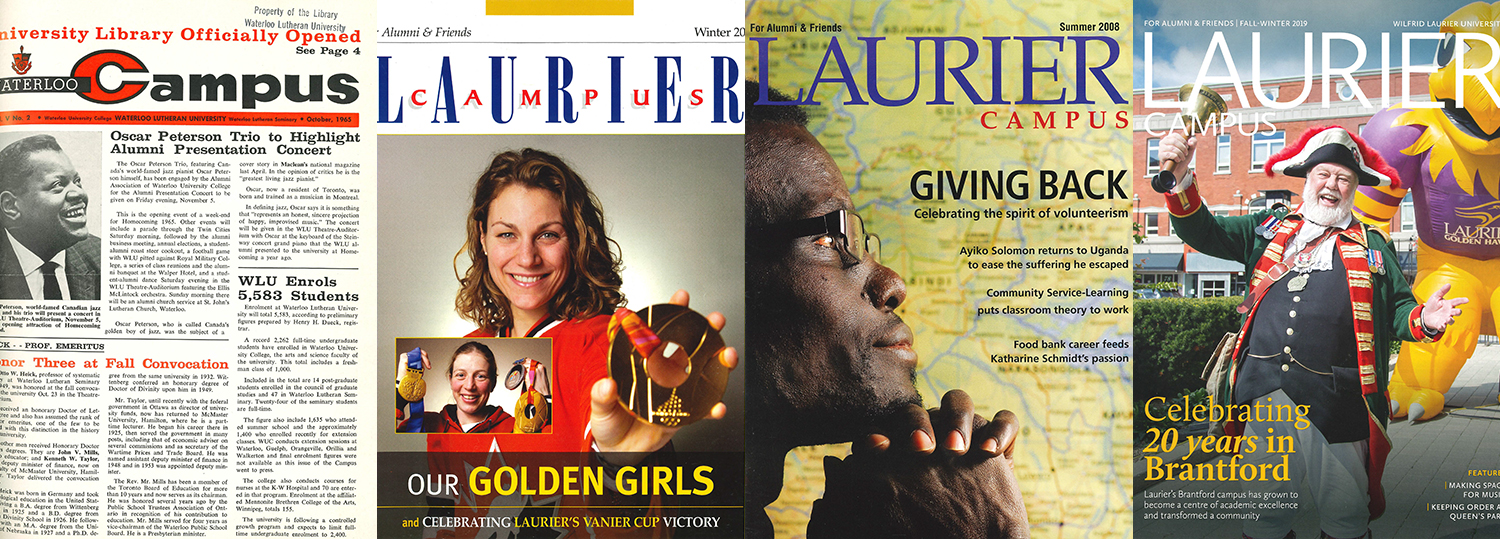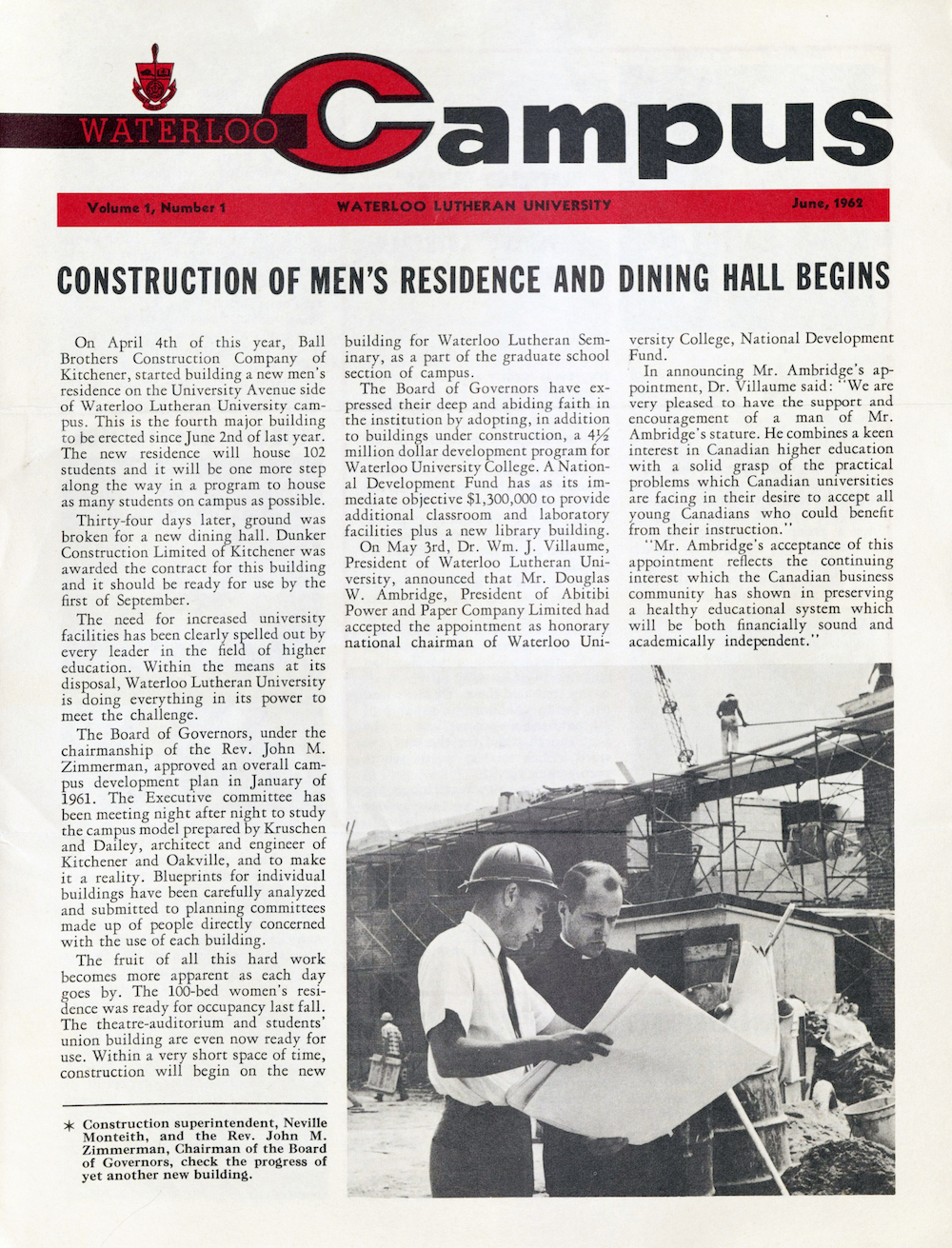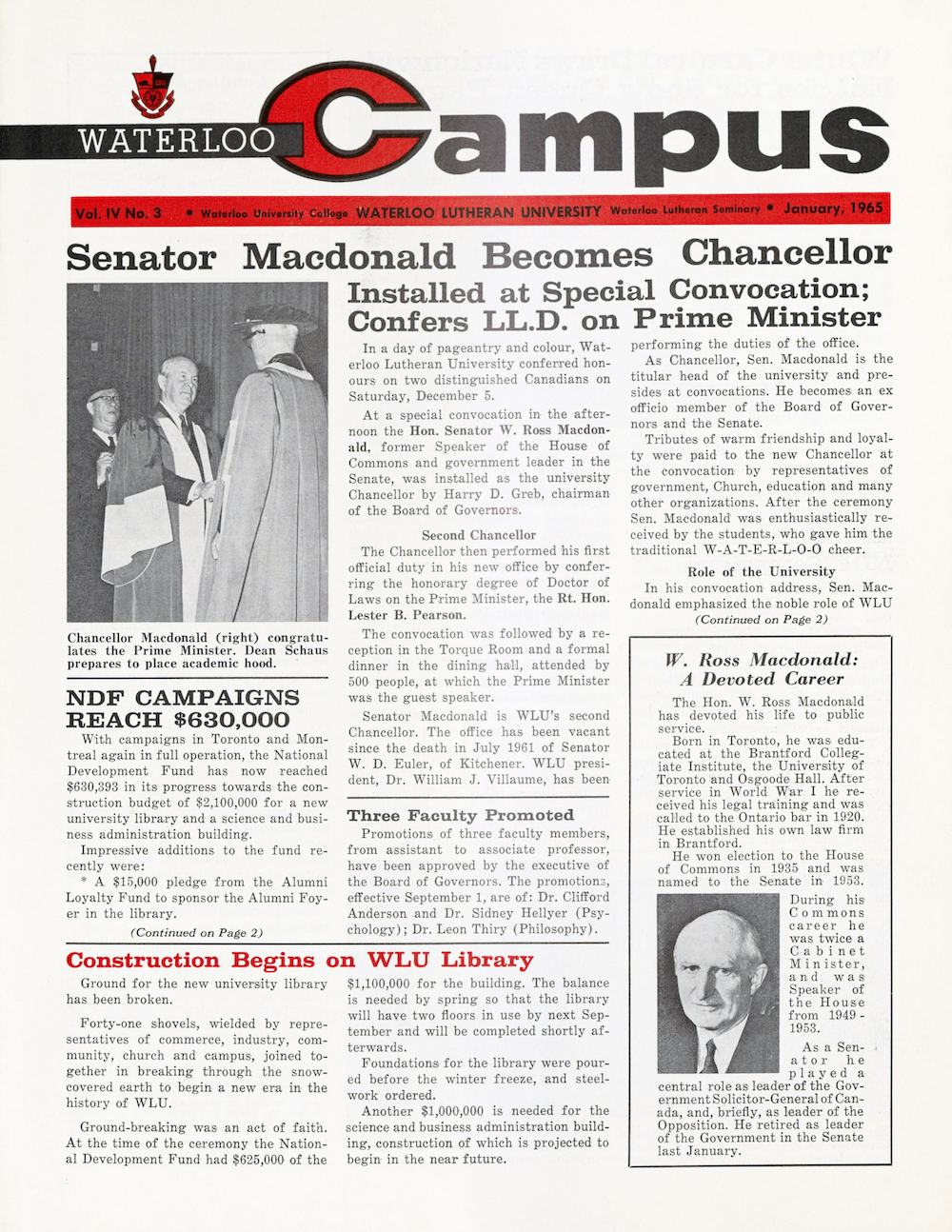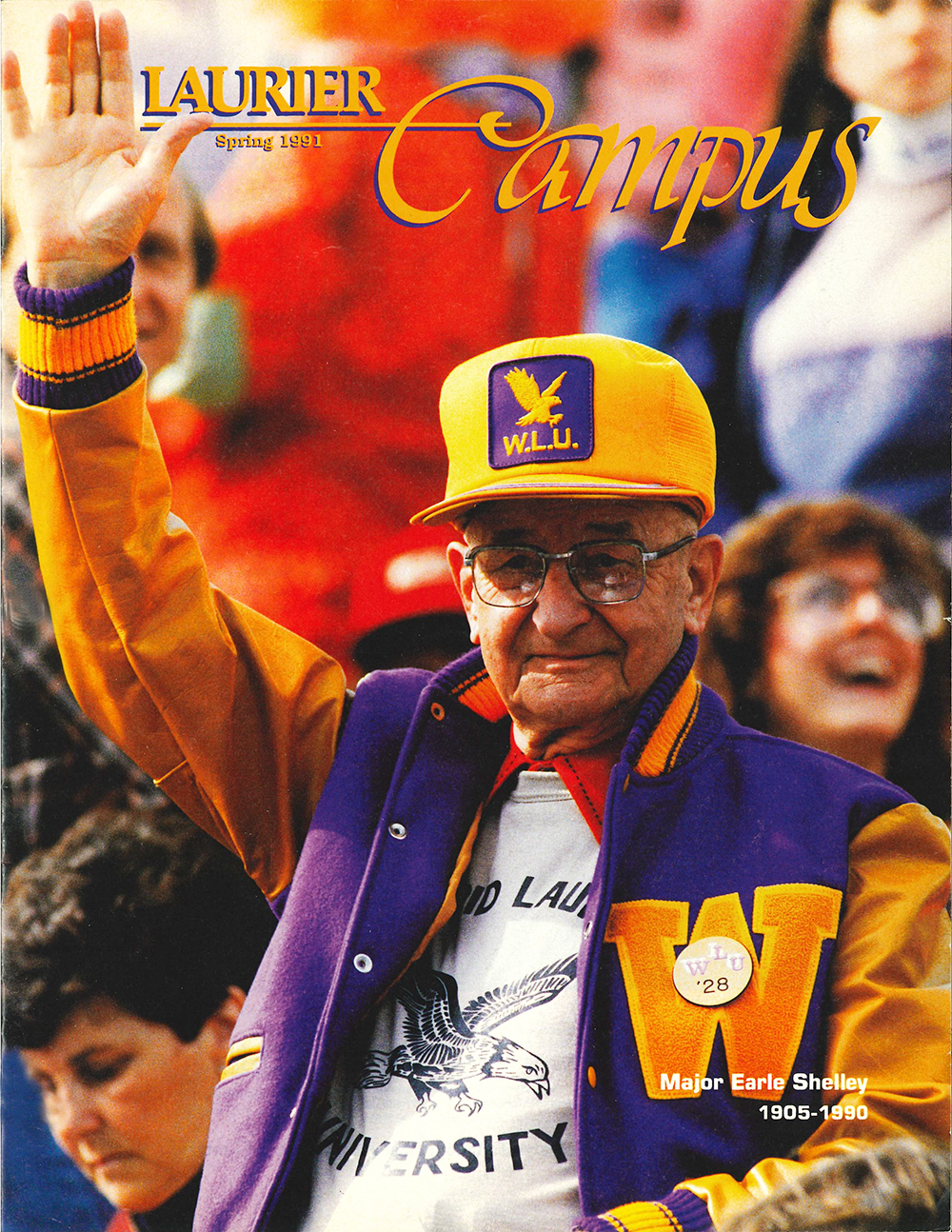
To get to the end of a story, it makes sense to start at the beginning. In the storied history of Laurier Campus magazine, that beginning is traced to Vol. 1, Edition 1, published in June 1962, when the magazine was known as “Waterloo Campus” and Laurier was known as Waterloo Lutheran University.
“To you and all of the recipients of this first edition of Waterloo Campus, I extend cordial greetings and the gratitude of ‘the campus family in residence,’” university president William J. Villaume wrote in his inaugural Waterloo Campus column. “We who study, teach, work and live on the Waterloo campus intend through this quarterly publication to communicate with the rest of the campus family.”
For more than 60 years, this magazine has done just that, keeping alumni and friends up to date about university news, research and academic endeavours; notable alumni stories and initiatives; and how Laurier is making a difference in its communities and the wider world.
The university is bidding farewell to Laurier Campus in this, the magazine’s final edition. It’s a big change after six decades, but one that will lead to new ways to stay informed about and communicate with Laurier.

Vol. 1, Edition 1, published in June 1962.
As managing editor Arthur Stephen noted in the spring 1987 edition of Laurier Campus: “Just as the university changes over the years, so too must publications that reflect it.”
﹋﹋﹋﹋﹋﹋﹋
The birth of Waterloo Campus magazine came during a time of significant growth for the university. Between June 1961 and June 1962, ground was broken on six new university buildings and enrolment was increasing. That growth was reflected in the front-page headline of the magazine’s first edition, which read: “Construction of men’s residence and dining hall begins.”
From that four-page first edition, Waterloo Campus grew in page count and scope of coverage. Soon, what would become regular features appeared, including “Alumni: Keeping in Touch” listings, faculty and staff notices, and In Memoriam. Later, feature stories profiling members of the alumni community were introduced. Homecoming was an important focus in early editions of Waterloo Campus, as well as convocation, with the magazine proudly highlighting the increasing number of alumni with each passing academic year.
– Arthur Stephen

The pages of Waterloo Campus and Laurier Campus magazine serve as a chronicle of the university’s institutional history, highlighting important moments, people and achievements during the past six decades.
A small sample of that history in past editions includes former speaker of the House of Commons W. Ross MacDonald being installed as chancellor of the university, highlighted in a January 1965 cover story. MacDonald’s first official duty as chancellor was conferring an honorary Doctor of Laws degree on then prime minister Lester B. Pearson as part of convocation ceremonies.
One of the biggest changes in Laurier’s institutional history took place in 1973, when Waterloo Lutheran University became Wilfrid Laurier University and the school entered Ontario’s post-secondary education system. The implications of the name change were many, including for this magazine, which in the December 1974 edition revealed a name change from “Waterloo Campus” to “Laurier Campus.”
Other historic magazine highlights include a new library opening its doors and the legendary Oscar Peterson Trio performing at Homecoming in 1965; the launch of Laurier’s co-op business program in 1975; and the opening of Laurier’s Brantford campus in 1999. Success in athletics was always celebrated, including Vanier Cup victories in 1991 and 2005, a national women's soccer title in 1992, and men's national soccer title in 2000.
More recently, Laurier Campus marked the university’s centennial with a special edition in 2011, launched an online edition in 2015, and continued coverage of significant events, milestones and initiatives, including the opening of Lazaridis Hall in 2017 and the launch of Laurier’s current Making Space for Music campaign to renovate the Faculty of Music building.
﹋﹋﹋﹋﹋﹋﹋
Celebrating the achievements of alumni – including the university’s newest – has always been a priority in the pages of Laurier Campus. A memorable example came in the winter 1990-91 edition of the magazine, when Social Work student Elizabeth Pittaway became Laurier's first-ever doctoral degree recipient.
“Her accomplishment represents a significant milestone in WLU’s academic development – a development in which all of our alumni can take tremendous pride, and which would have been impossible without your loyalty and encouragement," university president John Weir wrote to mark the occasion.
In 1992, Laurier Campus celebrated Florence Mowbray (BA ’92), who earned her Bachelor of Arts degree at spring convocation at the remarkable age of 86. Pittaway and Mowbray’s alumni stories are just two of hundreds shared in the pages of Laurier Campus throughout the years.
There were quirky ones, too, like this story from the summer 1987 edition: “Toronto's new downtown stadium now under construction was given its name – SkyDome – by Laurier grad Kellie Watson, 25, of Wallaceburg, who won two lifetime passes for every event held at the dome.”

Major Earle Shelley, named Laurier’s Alumni of the Century in 1977, was honoured on the cover of Laurier Campus upon his passing in 1990.
An examination of past editions also shows Campus has proven honest with its readers, even if the magazine was painted in a negative light. The March 1973 edition detailed a report by Toronto consultant Donald Duff, who recommended new directions for alumni relations at the university. The report was not complimentary to this publication, then still known as Waterloo Campus. As reported on the magazine’s front page: “(Duff’s) report, summarized in this article, includes his conclusion that despite a substantial commitment… the impact of this magazine upon its readers is described as ‘minimal.’” (Editor’s note: we couldn’t disagree more.)
The years did not come without other challenges. During a time of austerity measures by the Ontario government in 1993, Laurier Campus managing editor Lynne Hanna detailed the difficult decision to reduce publication of the magazine from three annual editions to two. “Cuts to staff and salaries, in operating budgets, plans and services are realities with which we must contend daily,” Hanna wrote. “Laurier Campus is not untouched.”

Whenever a need has presented itself, alumni and friends have stepped up to support the university’s philanthropic endeavours, which have been a major focus of this magazine during the past six decades. Past editions chronicle fundraising campaigns longtime readers will remember, including Excellence in the Eighties, Bridge to the Nineties, the Sports Centre and Stadium Project, Campaign Laurier, Building Canada’s Best Business School, and Catalyst, among others.
There was fun to be had around fundraising, too. In a spring 1995 column titled “What's Up Chuck?” alumnus Chuck Tatham (BA ’85) offered the following humorous take.
“Whether you only read this so-interesting-you-can-hardly-put-it-down magazine, or actually sit down and write five rousing paragraphs about the joys of owning and operating your own ferret farm, the Alumni Association wants to know all they can about each and every graduate of a little place I like to call… Wilfrid Laurier University. And they also want to know your phone numbers because the library needs Astroturf, and they're still 50 grand short.”
That humour was reflective of the tremendous community spirit on display in the pages of this magazine throughout its history, with the pride and dedication of alumni community members shining through. It’s a pride and dedication often encapsulated in columns written by Wilfrid Laurier University Alumni Association leaders.
“I got involved because I believed that whatever happened within the university community after I graduated was still going to have an impact,” association president Scott MacDonald (BBA '89) wrote in the summer 2003 edition. “Over the years, I have had the pleasure of working with too-numerous-to-mention volunteer alumni who have shared that belief.”
﹋﹋﹋﹋﹋﹋﹋
While this is the final edition of Laurier Campus, the magazine’s tradition will continue. Beginning this fall, an enhanced Purple & Gold, an online newsletter produced by Laurier’s Advancement team, will arrive in the inboxes of alumni and friends of the university. Like Laurier Campus, Purple & Gold will include university news and alumni profiles, as well as other elements included in this magazine, including Alumni Updates, In Memoriam and alumni events.
While alumni and friends can look forward new and engaging ways to remain connected to Laurier following this final edition, it is hard to say goodbye after so many years and so many memories. As the last word, a thought shared by president Villaume in that very first June 1962 edition of Waterloo Campus.
“We are proud of our alumni and friends, and we hope the entire campus family, in Canada and other lands, is rejoicing with us in the continued progress and increasing service of the university. We move into the future confidently, mindful of all that has been accomplished in the past and thankful for the unity of spirit which enables us to render even greater service.
“Those of you who have studied on this campus…have actively shared in creating this community and were in part molded by it. You will always belong to it because it is a part of you.”
Update your email to ensure you’re subscribed to Purple & Gold. Visit wlu.ca/switch.